Independence, flexibility, and unlimited financial potential — these are all inviting parts of a freelancing lifestyle.
This is especially attractive for employees who want more from their workplace. But, there’s still some mystery surrounding the enigmatic career choice.
As a freelancer, how do you make money? Where do you find work or jobs? How do you figure out what to do? What about insurance and benefits?
These questions are what typically stop people from pursuing a full-time freelance career. Keep reading for the answers to these questions and more, with expert insights from professional freelancers. You can also jump to the section you're looking for:
Chapters
What is freelancing?
Freelancing is doing contracted work for multiple clients and companies. A freelancer’s field of expertise can range from content creation to app development to tutoring. They are often called independent contractors or self-employed workers.
Over 60 million Americans freelance, including 46% of millennials and 43% of Gen Z workers. Also, based on economic trends, over 90 million workers will be freelancing by 2028.
Types of Freelancing
By freelancing, millions of talented people build their own businesses and find a bit more freedom in their day-to-day careers. Let's review the different types of freelancing and the roles that exist in today's marketplace.
| Industry | freelance opportunities |
|
Administrative Small businesses — and even other freelancers — always need help with administrative tasks. These organizations often hire any or all of these freelance administrative services. |
|
|
App Development Mobile apps are often as important as websites. Because of that, there are multiple freelance app development opportunities. |
|
|
Consulting Some businesses need help with strategy and planning (instead of creating deliverables). That's where these freelance consulting roles come into play. |
|
|
E-Learning E-learning has both popularity and business impact, especially for remote teams. Companies that want to offer an e-learning aspect but can't afford or aren't interested in building a dedicated e-learning team may benefit from e-learning freelancers. |
|
|
Graphic Design Graphic design is a critical piece of every organization's branding. Many companies choose to hire out these freelance graphic design services to help develop their brand or marketing assets. |
|
|
Miscellaneous New freelance opportunities pop up almost daily. These types of freelancing don't quite fall into any of the other categories on this list. |
|
|
Photography Whether for a business, publication, or wedding, photography is always needed. Photography freelancers typically specialize in one of the following photography niches. |
|
|
Videography Videographers capture and deliver a highly visual experience for an audience. Because videography is such a specialized field, many companies opt to outsource these freelance videography services. |
|
|
Web Design Web designers create attractive website designs for your audience. Here are some of the common freelance web design roles. |
|
|
Web Development Web developers work with the behind-the-scenes coding and structure that supports the web design. Here are some freelance web development roles. |
|
|
Writing This freelance gig has grown exponentially in the last few years. Freelance writing opportunities include: |
|
Freelance Marketing
Freelance marketing is the work a freelance marketer does for one or more companies. Freelance marketing tasks may include content strategy, digital marketing, social media consulting, growth marketing, advertising, and more.
With so many components and specializations, it's no surprise that freelance marketing is a popular gig. As a freelance marketer, you could pursue roles like:
- SEO specialist
- Publicist
- Email marketer
- Social media marketer
- Ecommerce manager
- Product marketer or manager
- Content marketer, strategist, or director
Now that you know all the freelancing possibilities, it's time to figure out if freelancing is the best fit for you.
Is freelancing right for you?
Here are a few questions to ask yourself if you think you may want to be a freelancer.
Why do you want to freelance?
Are you looking for a more flexible schedule, or are you merely trying to escape your dreaded commute? Do you want to expand your professional horizon, or are you simply bored at work?
Pursuing freelancing for the wrong reasons will make it hard to keep going when the going gets tough.
There are no right or wrong answers, but it's important to find what’s best for you, your family, and your career goals.
To give you some perspective, here are some answers from fellow freelancers on why they decided to take the leap:
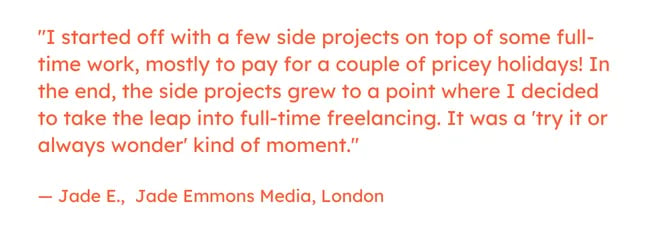
Can you afford to freelance?
A freelance career holds the promise of a higher salary and unlimited income potential. According to ZipRecruiter, the average annual salary for freelancers is $68,924. But salaries vary by industry, role, and experience. And it’s not likely you’ll see that income right away.
The first few months (or years) of freelancing may mean sacrificing income. It takes time to set up your business, establish yourself, and find clients.
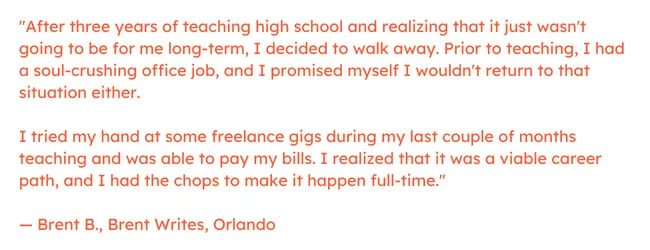
Are you comfortable with being uncomfortable?
Freelancing can be extremely uncomfortable. You won’t always know where your next paycheck is coming from and you’ll probably get rejected more times than you can count.
These thoughts and feelings are normal, so think of them as growing pains. After all, if it’s not challenging you, it’s not changing you.
Next, let’s talk about what kind of work you’d do as a freelancer. This step is another common roadblock for folks who want to freelance. Many aspiring freelancers aren't sure what to do at first. The answer can be simple, it just may take a couple of questions to draw it out.
What are your talents?
This four-word question can decide a lot for you. What are you skilled at? What do others ask you to do for them?
Notice that I didn’t ask, "What are you an expert at?" Experts are rare, and all you need to decide right now is whether you’re willing to become an expert.
What brings you joy?
This question doesn't always apply. While there will be days and times that you simply don’t want to work, there’s usually one skill set or profession that brings you joy.
What makes you feel good to accomplish? What are you proud to share with friends and family? This is probably what you’ll excel at as a freelancer.
The Pros and Cons of Freelancing
Regardless of fit or type of work, there are benefits and drawbacks to a career as a freelancer.
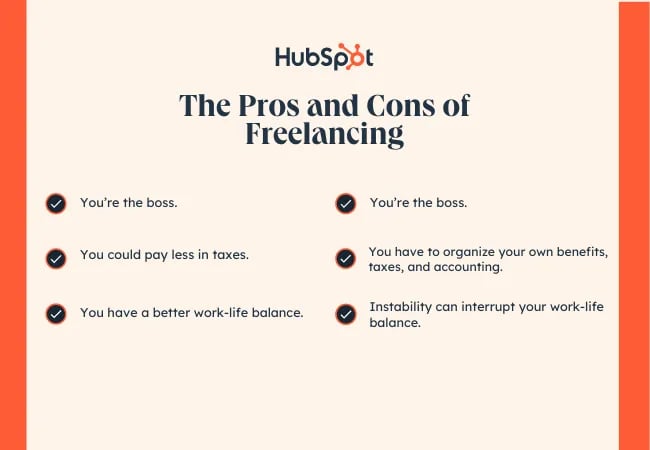
Advantages of Freelancing
You’re the boss.
You choose your schedule, rates, and which clients or jobs you want to take. If you feel like working in your pajamas, you can. If you want to take a three-week vacation, you can — it’s completely up to you.
You could pay less in taxes.
Freelancers can take advantage of more tax deductions on meals, travel, and more. Federal and state taxes aren’t withheld from each paycheck. Freelancers pay the IRS directly instead.
You (can) make more money. Freelancing is high risk, high reward. Your salary is whatever you want it to be. It all comes down to how much you charge and how often you want to work.
You have a better work-life balance.
Instead of commuting every day, you can stroll to your local coffee shop or take an hour to work out whenever you want. Freelancing doesn’t have to resemble a typical 9-to-5.
Disadvantages of Freelancing
You’re the boss.
Yes, I said this twice. When freelancing, you have to make all the decisions and do all the work, from client sourcing to marketing your marketing. You’re not just an employee of a business, you are the business.
You have to organize your own benefits, taxes, and accounting.
Freelancers don’t have employers to manage bookkeeping, cash flow, benefits, and taxes. They have to do it themselves with the help of tools or guides. And some of these expenses, like health insurance, are more expensive than through a traditional employer.
If you don’t work, you don’t make money. Sure, you can take a three-week vacation, but you may not make any money while you’re gone.
As a freelancer, your time is money. Spend it unwisely, and you could be giving up valuable income.
Instability can interrupt your work-life balance.
There are a lot of unknowns with freelancing, the biggest being where your next paycheck might come from. This instability can cancel out any work-life balance achieved through freelancing. For some, having stability and predictability in your career is worth a long commute or an unfavorable schedule.
The biggest motivations for freelancing are flexibility, freedom, and earning potential. And the biggest barriers are income predictability, finding work, and benefits.
If you’re not sure if freelancing is for you, you’re not alone. But according to 2022 Fiverr research, 73% of U.S. workers plan to freelance in 2023. If you’re one of the many, you’ll want to learn how to be the best freelancer possible.
How to Run a Freelance Business
The following sections touch on everything you need to know to start a freelance career, from branding to clients to making and managing your money. This will help limit the unknowns and equip you with plenty of knowledge as you pursue freelancing.
The information and recommendations in this article came from real freelancers across the world (including some HubSpot employees with freelance experience). It also includes real anecdotes and examples that will shed some light on what it’s like to be self-employed.
1. Getting Started as a Freelancer
Before you dive into completing jobs and making money, you need to set up your business. You need to know exactly what you’re doing and how you’re branding yourself.
This won’t only attract clients, but it’ll also offer direction when you feel stumped or at a loss for why you’re freelancing. Here are a few things you should know to make sure your freelance business survives in the long run.
Building a Brand
A personal brand is valuable when establishing authority as a freelancer. It also creates a long-lasting impression with clients. Whether you use a design tool like Canva or outsource your branding to an agency, personal branding should be one of the first things on your to-do list.
Business Name
Along with a memorable logo, your personal brand should also include a business name. You can brand your business after your own name or a third-party name.
Website
Another element of your personal brand is your online identity. This typically includes a dedicated website and social media accounts where you can display your logo and business name, portfolio, testimonials, and services. Every freelancer should have a website, especially if they work with clients remotely.
It’s good practice to match your website domain and social media handles to the name of your business.
For example, say you're a freelance marketer, and your business name is Phoebe Promotion, your website could be phoebepromotion.com and your social media handle could be @phoebepromotion. Congruity makes it easier for potential clients to search and find you online.
As for a website, platforms like HubSpot, WordPress, and Wix make it easier than ever to create and design a professional-looking site. These platforms also offer templates that you can use to display your work, like writing or design samples.
If you opt out of a dedicated portfolio site (which we’ll discuss below), these themes make it easy to integrate your sampled works into your website.
Social Media
Your social media accounts should also reflect your personal branding. Every platform has its own benefits and purpose, so don’t fret that you’ll need to be active on all of them.
For example, Twitter is good for sharing your portfolio and connecting with peers and potential clients. LinkedIn is great for publishing a live resume and making valuable professional connections. Facebook is handy for joining groups of like-minded people, and Instagram is valuable for publishing videos and photography.
There are other places that should reflect your personal brand, too. If you do local work or attend network events, business cards are a great tool to carry with you. Sites like Vistaprint or Moo help you easily create gorgeous print material. Your brand should also be on your proposals, invoices, contracts, and any other materials that go to clients.
Why is personal branding so important? A clean, consistent brand communicates authority and professionalism to anyone looking at your business. This one step will help you establish yourself as a trustworthy freelancer.
Creating a Portfolio
Whether you’re a freelance writer, designer, or web developer, a portfolio of your work speaks volumes to potential clients. Strong copy and testimonials can help sell your services. But portfolios feature your work in action, helping your clients envision your skills working for them.
Portfolios also save you precious time by letting clients know if you're a fit for what they're looking for before they book an initial call.
Should you include all your work in your portfolio? No. The work in your portfolio should be your best and show diversity in your skills and clientele.
Common ways of showcasing your portfolio are Dropbox, Google Drive, or links on your website. Here are some third-party portfolio sites you can use to feature your work:
- Contently — for writers, journalists, and content creators
- PortfolioBox — for designers, photographers, artists, and more
- CarbonMade — for illustrators, animators, architects, and more
- Behance — for graphic designers, illustrators, UI/UX, and more
- Journo Portfolio — for journalists and writers
2. Starting a Freelance Business
So, you’ve got a brand and a book of work to show potential clients. What else do you need to legitimize your business? Keep reading to learn more about establishing your business and setting yourself up for success.
Registering Your Business
Freelancers have some flexibility around the legal and financial structure of their business. Some freelancers remain sole proprietors and opt to receive 1099s and work from a personal bank account. Others register their business as an LLC to open a bank account and further protect their assets.
The decision is completely up to you. The only difference is that registering your business will likely cost you a fee. This article dives into the specifics of how and why you might want to register your freelance business as a limited liability company (LLC).
Setting Up Your Workspace
You’re set up online, now where are you going to work? Your physical workspace can massively impact your productivity, focus, and motivation. Keep this top of mind when considering your jump to freelancing.
Many freelancers choose to work out of their homes, whether for convenience, cost, or to be closer to family. A home office is ideal for work-life balance, but the dinner table, bed, and couch are also options. This article dives into how to create a home office that works.
These tips can also help you stay focused while working from home.
If it’s not realistic for you to work at home, don’t fret. Many of today’s work environments are remote and freelance-friendly. If you’re interested in co-working space, many cities have local co-working spaces that allow you to use shared desks, studios, and kitchens. These spaces also offer a place to network with freelancers and potential clients.
If you don’t have the budget for co-working space, find your nearest coffee shop, cafe, or library. Whatever space you choose, make sure it’s free of distractions and offers favorable work conditions.
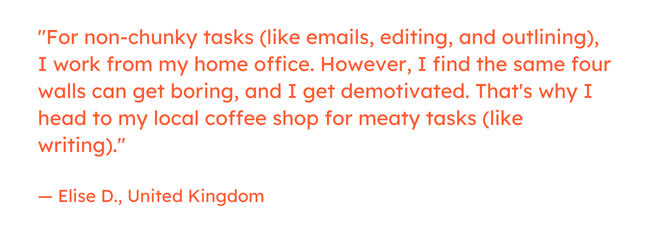
3. How to Find Freelance Jobs
When you start your freelance career, most of your day-to-day will involve looking for jobs and marketing yourself. It will take time to establish your skills and services and become well-known by clients.
Until then, you’ll need to put a ton of work into applying to gigs, contacting potential clients, and just getting your name out there.
Inform your friends, family, and professional network of your freelance business.
Even if they don’t need a freelancer, your name might come to mind if they’re asked if they know someone. The more people who know about your business, the more people who can refer you.
Join freelance job sites.
Freelance job sites give you access to open jobs and projects posted by clients. They also bolster your name and your business name by giving you another online space to promote your services.
Here are some common job sites on which you can establish a presence and check out some open gigs:
Join industry or location-specific freelance communities.
This will help you create a network of colleagues and freelancer friends as well as expose you to open gigs and potential clients. It might seem counterintuitive to make nice with your competition, but it can actually help your business. In fact, three out of my first five jobs came from another freelancer who couldn’t complete them all themself.
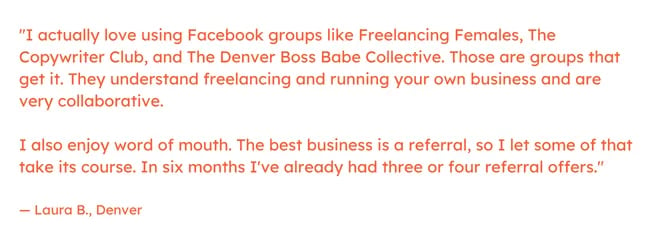
Inform your friends, family, and professional network of your freelance business.
Even if they don’t need a freelancer, your name might come to mind if they’re asked if they know someone. The more people who know about your business, the more people who can refer you.
Stay active on social media, like LinkedIn.
Follow and connect with freelancers, influencers, and potential clients on Twitter and LinkedIn. Engage with their posts by asking questions or sharing content with your network. I know multiple freelancers who landed work with an editor or project manager just because they liked what they had to say on social media.
Negotiate full or part-time jobs to freelance.
Your best freelance client could be someone you're already working with. To shift an existing relationship to freelance, the key is negotiation.
Before broaching the subject, put together a clear proposal for freelance work that communicates your rates and the value you can offer as a freelancer. Once a client accepts your proposal, be sure to get the terms of your agreement in writing. This can protect your relationship if needs change over time.
Contact companies you want to work with.
For this bold and direct approach, contact managers, directors, and editors at companies where you want to work. Share your availability and your website to stay top-of-mind when work comes up.
This outreach also shows clients that you’re proactive and take initiative when needed.
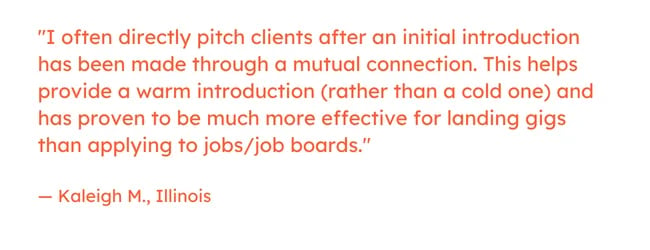
Establish authority in your niche.
Attend industry events (like INBOUND), teach a local course, or lead a seminar or webinar. One freelancer I know tutors writing students at her local library. Will any of her high-school-aged clients hire her? Probably not, but it still builds awareness of their business while helping others and challenging them to fine-tune their skills.
Work for free.
If you’re a writer, pitch articles to publications like Entrepreneur, Fast Company, or Inc. to build your portfolio and get bylines.
If you’re a designer, offer your work to a nonprofit for free to create goodwill and associate your work with a real client.
Note: Working for free is a controversial topic. Once you're established, don't hesitate to charge what you're worth.
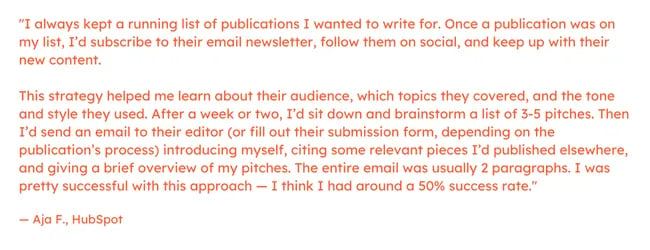
Ask for referrals and testimonials.
Reviews don’t have to come from paying clients. Anyone in your personal or professional network you’ve worked with can testify to your skills and work ethic. Consider professors, past employers or colleagues, or mentors. Ask for reviews on LinkedIn and copy them to your website.
Word of mouth.
Word-of-mouth referrals get a lot of buzz in freelance circles. It takes time to build a reputation with your clients that will lead them to share your skills with their network. But you can start the process with your first freelance assignment.
First, make a habit of submitting consistently excellent work on time. Then, find ways to track and thank your clients who spread the word about your services. This list of project management tools is a useful place to start your tracking efforts.
Say yes!
The best way to consistently attract work is to market yourself and your services. Marketing yourself extends beyond applying for specific gigs or reaching out to clients.
Promote your business as a whole and establish a presence on social media, publications, search engines, and more. Most of this work happens with little to no pay but more than pays off in the long run.
As you establish yourself as a freelancer, keep your mind open to new opportunities. You never know what could lead to a client or job.
![Freelancing quote: “[The best decision I made as a freelancer was when] I went through a period of saying yes to everyone that asked for help. It wasn't until I started to respect my expertise that others seemed to, too (minus the example from above...). It's easy to fall into that trap, but if you don't appreciate your time and talent, neither will anyone else.” — Lauren G., PR and Prose, Amsterdam](https://blog.hubspot.com/hs-fs/hubfs/freelancing_15.webp?width=650&height=250&name=freelancing_15.webp)
4. How to Set Freelance Rates
You’ve established the foundation of your business. Now this section will equip you to set your freelance rates.
Setting rates and determining fees may be the hardest part of freelancing. It can be awkward to talk about money and setting rates for your services can be tricky. What are you worth? What if your clients don’t agree?
Setting and negotiating rates can feel quite personal, but the key to discussing money comfortably is to take feelings and opinions out of it. Instead, use an economic approach to determine your rates, the same way a business owner prices their products.
![Freelancing quote: “[It’s all about] knowing your worth. It's so hard to see yourself as a commodity, but that's what freelancing is. You're selling your skills as a service. How do you put a price on that? In the beginning, this is truly a hard thing to grasp. But with experience and speaking to peers, you slowly start to figure that out.” — Karine B., The Letter K, Canada](https://blog.hubspot.com/hs-fs/hubfs/freelancing_5.webp?width=650&height=250&name=freelancing_5.webp)
Here are a few popular strategies freelancers use to set their rates. You can also use a combination of the three.
Cost-Plus Pricing
Cost-plus pricing is determining how much it’ll cost you to complete a project and tacking on 10-30% as profit. This pricing model is best for artists and freelancers who use physical material and know the cost of completing a project or service.
For writers, designers, and developers, this model might be tough to calculate, unless you’re counting your time as the primary cost.
Market Rate Pricing
Market rate pricing involves taking a look at market averages and deciding your rates based on those around you.
To calculate your prices based on market rates, take a look at your industry, location, and competitors with similar experience.
Keep in mind, as a novice freelance marketer, you don't want to compare your rates to a marketer with 10+ years’ experience, even if you live in the same area.
Here’s a list of average rates per industry:
Value-Based Pricing
Another pricing approach is to base your rates on what you believe your work is worth. This means that your pricing will differ slightly depending on what client you’re working with and what kind of work you’re creating.
For example, creating a commercial for a Fortune 500 company may hold more value than a video for a local coffee shop, so you’d likely charge more for the former. That’s not to say one company has more value than the other. But it allows you to take what they can afford and the potential impact of the project into consideration.
How often should I charge clients?
Some freelancers charge by the hour, while some charge per project (or per word for writers). Base this decision on the type of work you’re doing and what you’re most comfortable with.
Hourly fees ensure you’re paid for all your time, while a fixed price guarantees you’ll make a specific amount. Pay by the hour puts emphasis on the value of your time, while fixed pricing puts more emphasis on the value you’re delivering your client.
Should I publish my freelancing rates on my website?
Again, this comes down to what you’re most comfortable with. Some freelancers opt to publish their prices to create a perception of value. This approach helps weed out clients who can’t afford your services.
Other freelancers withhold that information to get clients on the phone. Keeping your prices private also allows you to change prices when need be.
![Freelancing quote: “I publish [my rates]. It means that people can get an idea of what I charge before they contact me, which makes everyone a lot more comfortable with the pricing conversation at the end. My rates are based on surveys of my peers and what people at my level of experience charge.” — Angela R., Australia](https://blog.hubspot.com/hs-fs/hubfs/freelancing_2.webp?width=650&height=250&name=freelancing_2.webp)
5. Managing Freelance Jobs and Clients
Freelancing means that you’re in charge. You create your schedule, you set your deadlines, and you pick up the slack when things go wrong.
The best way to prevent problems (and impress your clients while you’re at it) is to have a solid project management process in place. Not only will this help you approach each project with assurance and organization, but it’ll also communicate professionalism to your clients.
![Freelancing quote: "I'm a huge fan of over-organization so I use tools to get myself organized and get stuff done so I can get paid faster. Using [tools] also gives clients a great impression that you've got it together and takes the pain out of choosing to work with you!" — Owen W., British Columbia](https://blog.hubspot.com/hs-fs/hubfs/freelancing_9.webp?width=650&height=250&name=freelancing_9.webp)
The first step to managing your projects with ease is establishing a place to record deadlines, meetings, events, and important dates. This could be on your calendar, bullet journal, or online planner.
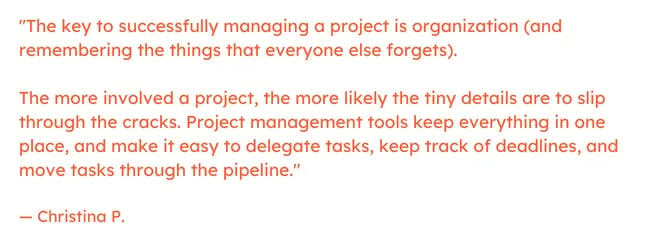
Beyond your calendar, it helps to use a project management or to-do list tool (or a combination of some) to help you stay on track and hit deadlines. From a HubSpot poll of over 80 freelancers, here’s a list of the top five platforms they use to manage their freelance work:
- Trello (used by 28%)
- Asana (used by 17%)
- Google Docs
- Basecamp
- Toggl
Lastly, figure out how you’d like to communicate project information and updates to your clients.
As for how often you’ll communicate with them, that’s also up to you. It'll likely take some time and practice to figure out.
Remember, as a freelancer you not only need to create amazing work but also please your clients, as clients lead to referrals — which leads to more work.
Here are a few more tips for working with clients:
Set expectations early.
From the moment you begin working with a new client, make sure no question goes unanswered. Be proactive in setting expectations for projects, your personal availability, deadlines, and payment.
If you feel like you’re providing too much information, you’re likely providing just enough.
Put it on paper.
Whether you’re connecting with clients over email, phone, or Slack, make sure all decisions and expectations show up in official documents. This includes proposals, contracts, and invoices. This creates legitimacy for your freelance business. It also creates official documentation if things go awry.
Watch out for client "red flags."
If a client starts asking questions about availability and payment that make you uncomfortable, listen to your instincts and consider whether you want to work with them. It’s OK to say no.
Questions like "Will you be available any time I call?" or "If I don’t like it, do I still have to pay?" are examples of red flags and might mean that the client isn’t a good fit for your business.

6. Getting Paid for Freelance Work
Money, money, money. We all need it, but not everyone has to manage it as meticulously as freelancers do.
When it comes to money, setting your rates is only half the battle. The other half involves billing, getting paid, and managing your freelancing financials.
The process of billing and receiving money can be uncomfortable, but it keeps your business alive and allows you to maintain your freelance lifestyle. Thankfully, technology has made it easier than ever.
Use a tool for financial management.
With the right tools, it's easy for today’s independent workers to manage their finances within a single platform.
Here’s a list of the top four financial management tools per recommendations from over 80 freelancers:
- Wave (13%)
- Quickbooks (10%)
- Freshbooks (10%)
- Xero
These tools can help you upgrade from spreadsheets to invoicing, processing payments by direct deposit, and more. These tools also make it easy to add taxes and fees or handle reminders for clients who missed a deadline for payment.
And speaking of payments — one important thing to know about freelancing is that sometimes clients don’t want to pay (or they don’t pay at all).
There are some measures that can help if this happens. At the same time, you'll want to follow these invoicing best practices to minimize this risk.
Bill at least half upfront.
It’s not uncommon to ask for at least 50% down before starting work. This is a show of good faith from your client and offers some funding upfront so you can get to work.
Be clear on your invoice.
Spell out all your pricing, due dates, and payment terms on your invoice. Leave nothing to chance. You never know when a client will try to wiggle out of what they owe you.
Bill promptly, based on your terms.
If you say you’re going to bill weekly, bill weekly. If you say you’re going to bill five days post-project, then do so. Be true to your word. It shows professionalism and trustworthiness, and it keeps your clients from silently backing out of what they owe.
Offer multiple payment options.
The tools mentioned above can process multiple forms of digital payment, but it’s also good practice to offer to accept payment in other formats too.
Be sure your business address or P.O. Box is prominent on your invoice so that clients can send you a check if need be. Accepting all forms of payment leaves no room for your client to say, "Sorry, I just can’t pay."
7. How to Pay Taxes as a Freelancer
First, congratulations on the income you're making as a freelancer. Your next step, well before tax time, is to talk to a tax professional.
Tax laws and procedures vary by country, state, and sometimes county, so you'll want to cover the details with an expert.
Until then, these common tips can help you prepare for your first tax season as a freelancer.
Put taxes aside after every payment.
It’s good practice to "pretend" taxes are being removed from each invoice you receive, as an employer does. If you're freelancing in the United States, it's a good idea to set aside at least 30% of your income to cover taxes.
Besides income tax, this will need to cover a 15.3% self-employment tax as well as any state or local taxes.

Look at different business types as your business grows.
While most freelancers file taxes as sole proprietors, you may want to look at other business structures as your income grows. Different business types can have a positive impact on your tax obligations, liability, and more.
Keep clear and easy-to-find records.
The easier it is to locate forms, invoices, and receipts, the simpler it will be to complete your taxes. These records can also help you continue investing in yourself and your business with the possibility of deductions for:
- Workplace expenses
- Continuing education
- Credit card interest
- Health insurance
- Mileage and travel expenses
- Software
Think about paying quarterly taxes.
Some freelancers find it best to make quarterly tax payments, so you may want to take a look at that option.
Instead of paying one large sum each April, you'll pay an estimated tax amount each quarter. This relieves your bank account of a massive withdrawal and helps you avoid any late fees or potential interest payments.
8. More Not-So-Fun Freelance Stuff
When you're working for an employer they take care of a lot of stuff besides taxes — including benefits and retirement.
You can set up your own benefits and retirement, but it takes some extra research. Check out the need-to-know details below.
Setting Up Insurance
Company-sponsored benefits are important, especially for folks with families and chronic health issues.
If you have a spouse or domestic partner, take a look at their insurance options. This is the most ideal avenue, as company-sponsored benefits are usually less expensive than direct options through insurance providers. Even if your partner has to pay a little more to upgrade to an employee plus partner or employee plus family plan, it could be worth it.
If you don’t have a partner or they can't include you in their benefits package, don’t fret. There are several plans and providers that cater to freelancers and self-employed people.
Check out these resources below:
Investing in Retirement
You don’t need an employer to set up a 401(k) or IRA. Freelancers and self-employed folks have many of the same options as those who work for a company, such as a gold IRA, Roth IRA, SEP IRA, or self-employed 401(k). This article by Fidelity breaks down which account might be best for you and how to get started.
As a freelancer, I started a Roth IRA and set up direct deposits into the account. I did this directly through my personal wealth manager, but there are plenty of tools and platforms that can help you.
Regardless of how you plan to invest in retirement, always start as early as possible and stay consistent with your deposits. Your future self will thank you.
9. Staying Connected as a Freelancer
Freelancing can be a lonely career choice. In fact, when talking in-depth with over 20 freelancers, most said the most difficult part of being a freelancer is how lonely and isolating it can be.
But this shouldn’t stop you from pursuing a freelance career — it should simply prepare you to put in a little more work socially.
If you’re not going into an office anymore, you may find yourself spending more time alone or that you talk to yourself more often — or that may just be me.
Either way, freelancing means stepping outside your comfort zone. You may need to work hard to build relationships and join communities — just like you’d do at work.
Meeting others can help you stay connected and up-to-date on new jobs and freelancing trends. Here are a few ways you can stay connected and keep learning as a freelancer.
Take an Online Course
Taking an online course is a fantastic way to inexpensively learn a new skill while connecting with a new network of people.
Some courses are free, and others offer certifications to increase your credibility. Online courses are a great asset to a budding freelance business and are much, much more manageable than going back to college.
Here’s a list of courses recommended by the 80+ freelancers we surveyed:
Writing Courses
- HubSpot’s Content Marketing Certification
- Copywriting for Creatives
- 10x Emails
- ConversionXL
- Copyhackers’ Copy School
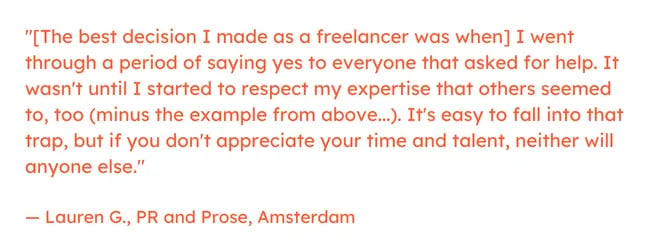
Design Courses
Marketing Courses
Business Operations Courses
Freelance Marketing Courses
Coding and Analytics Courses
Along with these courses, you can also check out dedicated course websites. Platforms like Udemy and Treehouse offer hundreds of free and paid courses that cover a range of topics and specialties.
For more resources, check out HubSpot Academy for Freelancers.
Find a Mentor
When I started freelancing, finding a mentor was the best thing I did for my business. I didn’t need help writing — I needed help figuring out how to write for other people and make money doing it.
My mentor showed me exactly how to be a freelancer, including how to find business, pitch myself, set my rates, and more. Without her, I wouldn’t have started out so strongly with my freelance business.
Not only did she equip me with all the tools and confidence I needed to dive in, but she also passed along a few jobs that she couldn’t take herself.
The process of finding a mentor, coach, or consultant isn’t the same for everyone. You may find a mentor in your local community or hire a mentor for help. Depending on your budget, industry, expertise, and location, you might take a coaching course or connect with a local consultant.
Join a Freelance Community
Whether you’re working from the heart of New York City or middle-of-nowhere New Mexico, today’s technology makes it easy to stay connected to other freelancers. From social media to dedicated forums, there are plenty of ways to join communities, build a network, and make friends.
Sites like Freelancers Union offer memberships that offer resources and access to communities of freelancers around the world.
As for social media, there are plenty of freelancer Facebook groups you can join and engage with. Some groups give work, while others simply offer a place to chat and ask questions. If you’re on Slack, you can also hop into a freelancer Slack community.
Lastly, don’t shy away from your local freelance network. Nothing quite beats a face-to-face meeting or conversation over a cup of coffee. Organizations like Creative Mornings or local co-working spaces put on networking events and get-togethers that allow you to meet other freelancers in your area. These opportunities offer human interaction in an otherwise majorly digital lifestyle.
How to Be a Successful Freelancer
Now that you have a foundation for your new freelance business, it's time to refine your strategies. Over time, you'll start to learn where you need to develop and when you excel.
These tips can help you focus on the most important details from the start.
1. Find a niche.
While it can seem like the broader your skills are the more likely you are to find freelance clients, the opposite is often true. Employers are often looking for a freelancer that understands their unique industry and challenges. Find the right niche and you're more likely to offer real value.
For example, popular freelance writing niches include finance, real estate, education, and wellness.
To choose your niche, begin with your personal interests and your professional experience. The places where these overlap could be your best niche. Other ways to find your niche include:
- Trying different industries and specialties
- Market research
- Looking at top-paying niches
- Following your passion
2. Do some competitive analysis.
As you launch your freelance business, you might need to do some competitive research.
Learning from the strategies of top freelancers in your industry can help you understand what clients are looking for. It can also help you improve your marketing, proposals, and more.
This strategy can also help you find gaps that you can fill in your industry. Use these free competitive analysis templates to research your competitors for insights.
Free resource: Competitive Analysis Templates
3. Track your time.
There are many free time tracking apps for freelancers. These can help you track your billable time for projects. When you're the boss, you don't need to track your time. But even if you only track your time with your first few clients, time-tracking tools can help you see how much time each task actually takes.
They can also help you better budget and prioritize your time and can offer reminders to take breaks to avoid burnout.
4. Keep developing new skills.
As you develop your freelance business, continued education can keep your skills relevant. This habit can also open up new client opportunities.
Massive Open Online Courses (MOOCs) are a great way to build new competencies. For example, freelance marketing changes constantly. This list of over 40 free online marketing classes can help you build skills in the areas you want to develop.
Popular skills that can be useful for any freelancer include:
- Data science
- Cybersecurity
- Coding
- Video production
- Sound editing
- Content writing
5. Create and stick to personal deadlines.
Working independently is exciting, but it can also get overwhelming. If your clients have flexible deadlines, it's easy to get in the habit of putting off projects until the last minute. This means a lot of wasted time and lost chances for extra income.
So, instead of relying on client deadlines to stay on task, break your deliverables into smaller projects and set a deadline for each one.
It's also a good idea to use tools and templates to organize ongoing projects. For example, social media content can be tough to organize because of the volume and variety of content. But this social media content calendar template makes it easy to see the big picture at a glance. At the same time, it creates space to plan for the details needed to meet client expectations.
It's also a good idea to give yourself rewards for meeting deadlines to stay motivated.
6. Communicate your value.
Promoting yourself as a freelancer can feel uncomfortable to some people. If this is you, there are a few ways to sidestep those awkward feelings and build excitement for your freelance business.
As you develop a reputation with clients, you can let their appreciation speak for you. Until then, there are a few authentic and easy ways to share your value as a freelancer.
First, focus on results. Track analytics for every project so you have data-driven stats to share in your freelance marketing.
Next, use templates to help jumpstart your promotions. For example, these professional bio examples and templates can help you create a freelance bio that covers everything your prospective clients need to know.
Finally, let your personality shine. Your likes and dislikes, sense of humor, and aesthetics will show up while you're working with clients. Including what you love in your promotions lets your clients know who you are and what a joy it is to work with you.
7. Ask top clients for testimonials.
As your freelance business grows, don't forget to keep asking for feedback and testimonials. This query can sometimes feel awkward, but there are a few ways you can make asking for testimonials feel fun and easy.
First, ask if you have permission to use texts, chats, or other digital conversations as a testimonial. You can also ask to draft a summary of feedback and ask your client to edit your copy.
Testimonial exchanges or follow-up forms are great approaches too. Check out this post for a free template and more suggestions.
8. Create a blog.
Your first marketing plan may not include a blog, but it's a great investment for long-term results. Whether you use your blog to highlight relevant industry keywords or emphasize your personality, it's a smart way to promote yourself as a freelancer.
Check out these resources for tips on how to create a powerful blog, craft a blog post, and more.
9. Start freelancing on the side.
If you're not sure whether you can reach your goals by freelancing, but you're excited about the possibility, take the first step.
Many freelancers begin their businesses while working another job. If you begin your freelance business with a reliable income stream you'll have time to find the right niche, clients, and more, without too much risk.
You can use this time to test your skills and interest in freelancing, then decide on the goals you want to reach before you freelance full-time.
If this sounds appealing to you, be sure to check your employer's policies on freelancing. You want to be sure you're able to balance your new responsibilities before making a big investment.
Make Freelance Marketing Part of Your Bright Future
This ultimate guide to freelancing covers the many steps that go into this massive career move. But don't get discouraged or overwhelmed.
In fact, freelancing is a pretty straightforward process. Once you answer questions about your personal brand, where to work, where to find jobs, and staying connected, there's just one more question. Are you ready to take the leap?
Editor's note: This post was originally published in July 2018 and has been updated for comprehensiveness.













